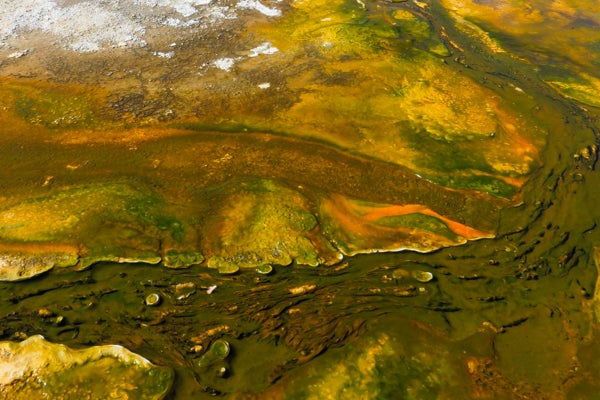The biodiversity of heat-loving bacteria in Yellowstone rivals a rainforest
Listen 4:29
Heat-loving bacteria, called thermophiles, thrive in the run-off channels of Pump Geyser where millions of microbes connect to create long strands, or filaments. Flowing water helps weave the filaments into bacteria mats that can be as thin as tissue paper or as thick as lasagna. (Rebecca Huntington/for WHYY)
Blue, dark peach, bright red, orange — thermophilic organisms make the hot springs so colorful you’ll want to grab your selfie stick.
Some organisms really thrive in the heat. In the geysers of Yellowstone National Park, you find all kinds of thermophiles — bacteria, viruses, funguses — living in water hot enough to blister your skin.
Thermophiles — ‘thermo’ for heat and ‘phile’ for lover, they’re literally heat lovers.
Rebecca Roland is an interpretive ranger, who educates visitors about the park’s natural and cultural history.
She and I line up with more than 3,000 visitors, crowding in and all waiting with cameras for Yellowstone’s most famous geyser, Old Faithful, to erupt. The geyser shoots up columns of hot, steamy water about every 90 minutes. The water can be as hot as 204 degrees and the steam can exceed 300 degrees.
While visitors take pictures of the spouting column of water, Roland says what’s really amazing is underneath their feet. To get a really good look at the thermophiles that make the geyser basin so colorful, she heads up the boardwalk to a less famous spot.
Along the way, the hillside is covered in white mineral sand and looks like a moonscape. Hot water burbles like witches brew making the ground thump like a drum.
Roland stops at Pump Geyser, which is like a mini Old Faithful. It spits out four- to five-foot-high columns of water before settling back down. As all that hot water runs down the hillside, it creates an ideal environment for heat-loving bacteria.
“It has one of the most lush and prolific bacteria mats in the park,” she says.
Thermophilic bacteria are too small to see with the naked eye but you can see them when they grow into colonies called bacteria mats. From a distance, the mats look kind of like a felt carpet just under the water’s surface. She bends over the boardwalk to get a closer view of what looks like an underwater forest of tiny Dr. Seuss trees.
“This bacteria mat is thick like a vegetable lasagna,” she says. “You have a layer of slime and a layer of crunch and then a layer of slime and a layer of crunch. The crunch is the silica, the sinter, and the slime, of course, is the bacteria.”
A whitish mineral deposit lines the hot springs. Scientists call it sinter.
“Right at the center of each feature where it’s bright blue, usually that’s where you have things like archaea and viruses that can grow above that 170 degree threshold,” she says.

Different temperatures cause different effects.
“Below about 163 degrees then you start in with the different types of bacteria, the thermophiles that like that really hot water, and you’ll start in with a pale yellow color … and then you go out a little farther and you start heading into the darker peach colors. A little bit farther, you’ll get some of the brighter oranges,” she says.
As you get further from the bright blue pool, the water begins to stream out like river channels braiding back and forth across the white sandy soil.
“We’ve got runoff channels with streamers and colonies of bacteria there. I love the streamers, they’re my favorite. They’re waving. It looks like feathers, waving in the water,” she says. The bright red or orange streamers contain carotenoid pigments that act as sunscreen so the colors shift with the intensity of the sun as the microbes produce more or less to shield themselves.
The water in the runoff channels is as warm as bathtub water, if you only turned on the hot water tap, Roland tells park visitors.
“When you have a lot of water and it comes down from the features in varying grades of temperature, you get a lot of opportunity for varying organisms to grow,” she says.
In fact, the colonies thriving under Yellowstone’s boardwalk boast as much biodiversity as a rainforest, Roland says. That makes Yellowstone a lab for scientists, who have already identified many kinds of thermophiles living in the park’s geysers.
“In the past, they’ve actually found thermophiles that digested oil in oil spills. The enzymes that you use in your laundry detergent are heat tolerant because of original enzymes from Yellowstone,” she says.
Scientists love visiting the park as much as tourists do, but the researchers are hunting for the next great breakthrough.
WHYY is your source for fact-based, in-depth journalism and information. As a nonprofit organization, we rely on financial support from readers like you. Please give today.





